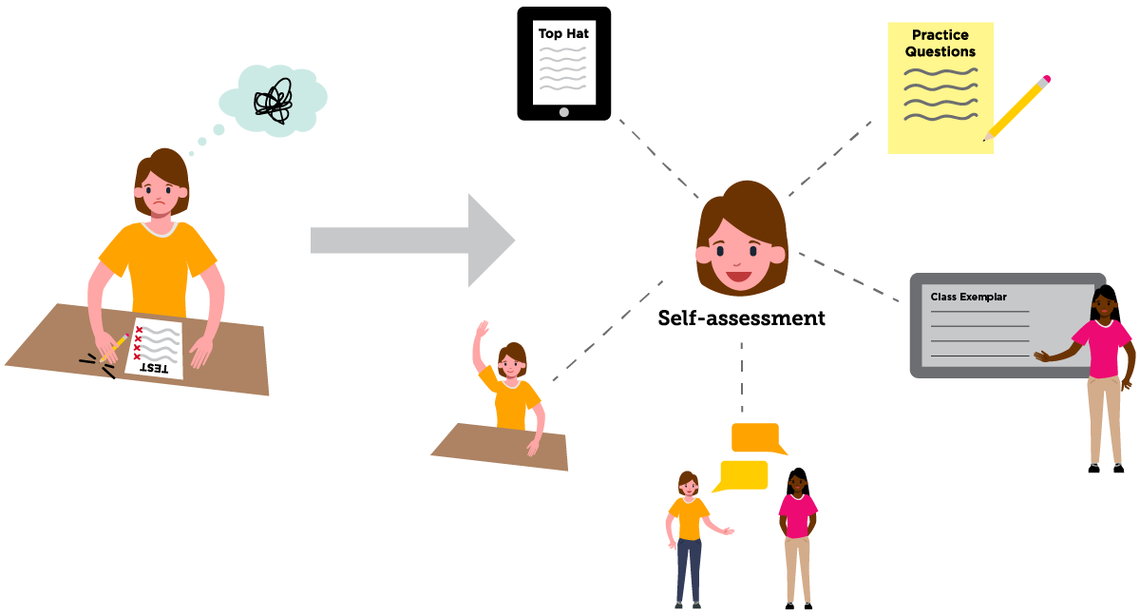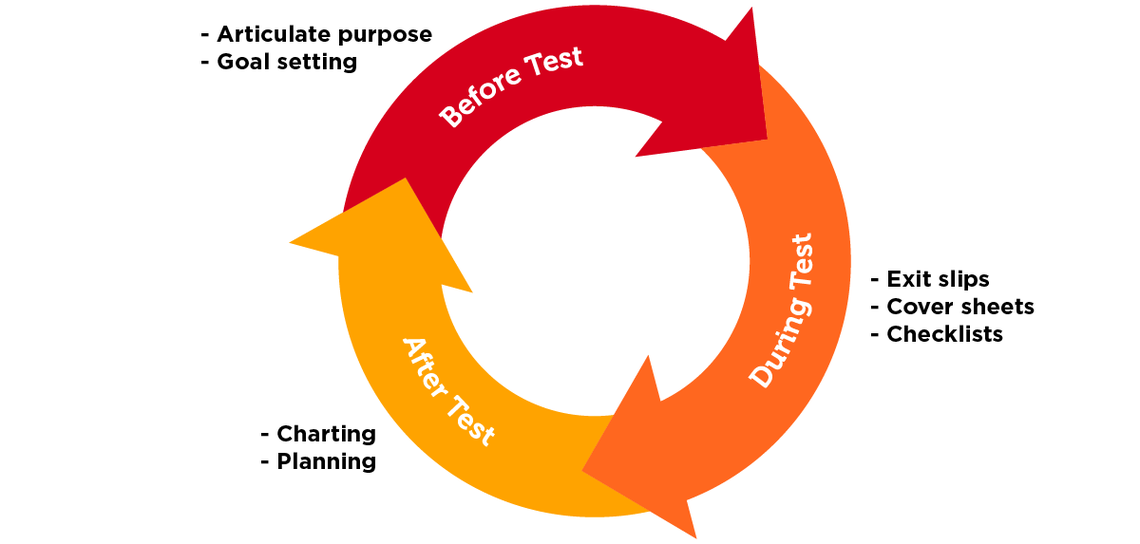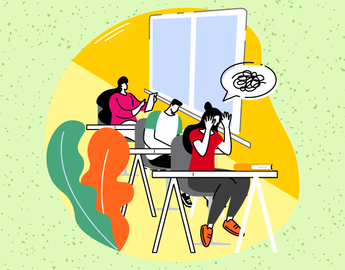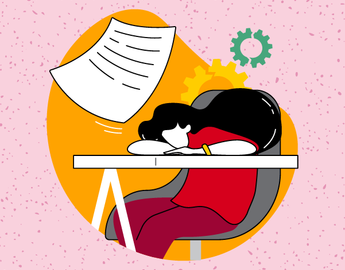Supporting student self-assessment

Aligning with feedback, students’ self-assessment of their learning can also help the student refine their learning. Much like feedback use, self-assessment is also associated with students who have a growth mindset. Having students understand and engage in self-assessment encourages students to reflect on their learning and their progress towards their learning goals, and ultimately supports their lifelong learning (Leach, 2012). Ideally, self-assessment is part of all elements of the learning process, such as before, during, and after the performance.
Research suggests that many students are not accurate in the predictions they have about their future performance. Expectations for future performance are often influenced by self-serving bias and ego protection (Wüst & Beck, 2018). Many students, particularly students who are struggling, will overestimate their future grades even when they are provided feedback on their past performance. High-performing students may have the reverse response of underestimating their future performance. As such, students’ desires or fears may impact their assessment of their performance.
Students may not distinguish between self-assessment and self-testing. Self-testing involves completing questions and evaluating how correct they are. In contrast, self-assessment addresses how deeply the material is understood. Ideally, Self-assessment is a calibration process (Nieminen & Tuohilampi, 2020, where students consider what approaches were used in the learning, their effectiveness, and adapting these approaches to meet goals.
Reflections around testing
By incorporating reflective activities for students through the assessment process, students will have support to build their feedback literacy and self-assessment skills.
Getting a student to reflect on their learning often involves the following: (The University of Edinburgh, n.d.)
-
Recall: the student remembers the idea, event or process.
-
Recaption: the student makes meaning from the idea or event.
-
Relate: the student connects the meaning to other experiences.
-
Rationalize: the student builds a general principle or rule.
-
Redirect: the student plans to continue or change action based on desired outcomes.

Before the test
Encouraging students to reflect on their current learning can help them plan for the upcoming test. This planning prompts a sense of accountability, and students are less likely to break these commitments (Wüst & Beck, 2018).
Rather than focus on being correct or incorrect, identify the learning outcomes that students will demonstrate in the assessment and why they are important. Students have greater self-efficacy in a task with clear goals as they feel they have more control.
Rather than determining the content or format of a review session, have students participate in developing the review content. Consider using Top Hat, Menti, or Another Immediate Response to help students reflect on what they need to prepare for the assessment. The following questions are adapted from Cathcart et al. (2014).
-
Which of the following topics would you like to focus on next week?
-
Rank the following [topics] on your confidence in dealing with them?
-
Which approach would help you learn about [x]?
-
What learning activities will help you prepare for [x]?
Help students shift their self-testing to self-assessment by challenging them to reflect on their responses.
-
The “Why”: Have students provide “the why” behind both correct and wrong questions. This can be done individually or in small groups that share their findings with the class.
-
Develop checklists: Encourage students to develop a checklist that includes what steps they should do and where to look for common errors. Perhaps this is a student-created resource that can be referred to during the test (Grandoit et al., 2020).
Student describes experience with exams and feedback from instructors. Voice actor: Emmery Poppleton
During the test
Tests often mainly focus on student performance. Self-regulated learners will engage in self-assessment during the test which helps them to adjust their in-test strategies, control emotions and plan for the future.
In selected-response questions (e.g., multiple-choice), students have little ability to demonstrate partial knowledge. Considering using one of the following:
-
Provide partial marks for the eliminated answers (if the correct answer is incorrect).
-
Have students select one or two questions that they know they got wrong and have them explain their thought process in responding to the question.
After students have completed the test, provide students with time to fill out a cover sheet to indicate the kind of feedback that the student believes will help them improve in the future. The cover sheet helps to direct the feedback provided in the future while prompting students to reflect on their performance. This cover sheet may be more appropriate for the written or essay-style answers (Bloxham & Campbell, 2010). A cover sheet may help to reduce student anxiety about feedback by providing them input on what they will receive.
Students may struggle to remember their reflection during the test as they are focused on the performance process. The exit ticket could be a structured document or scrap paper that students can note the areas they need to review again and/or the challenges they faced during the test. It helps students to note what they feel they need to review or clarify about the exams and let them take it home after the exam. An exit sheet may help students who ruminate about their test performance by providing a more accurate recollection of their exam performance concerns.
After the test
In-class reflection can help students work with the feedback information that their test results provided. To support students’ use of feedback, the response needs to acknowledge students’ emotional reactions as well as be future-oriented. Consider trying some of the following approaches:
Separate the test feedback from the student’s ability. This could include acknowledging that the test results are only one point of feedback about the students’ performance. Helping students understand the purpose of test feedback can help them manage their strong affective reactions. Acknowledge the emotional response they experience, but also include that this response is transitory (Forsythe & Johnson, 2017).
Consider having students respond to a series of prompting questions when they first receive the feedback. This can prepare students for a more detailed review of the test results by priming them to be future-focused.
-
Sample reflective questions adapted from (Quinton & Smallbone, 2010): What do I feel about this feedback? (Acknowledging the affective); What do I think about this feedback? (Addressing the cognitive); Based on this feedback, what action could I take to improve my work for another test? (Acknowledging the future focus)
These sheets provide a guidance reflection on how the student prepared for the test, performed during the test, and will use feedback in the future. Students need to make the connection between their preparation and feedback, noting what was successful and what approaches need to change. Alternatively, the exam wrapper could have students reflect on conceptual understanding and problem solving to support self-assessment.
Ideally, test results are part of the feedback loop, where students have opportunities to ask questions and clarify understanding. This feedback loop helps emphasize the tests’ role in future growth. Considering the following option to create a dialogue around the feedback.
-
Small-group discussion: Have students discuss the test in small groups and explain their understanding of the concepts.
-
Incorporate test problems into learning activities: Consider having students complete similar questions or problems that they struggle with on the test. Ask students to explain how they approach the questions differently from when they were in the exam.
-
Anonymous questions board: Using the class website, create an anonymous questions board or survey. Some students are reluctant to ask questions because they fear how they will be perceived. An anonymous forum to see clarification can resolve this. Alternatively, some students may be more comfortable asking questions to the teaching assistant than asking the instructor directly. Note how growth and improvement are rewarded in the course.
Reflection questions:
Consider a test assessment that you typically use in one of your courses. What would be one activity that you could include to help students reflect on their learning? What part of the process would it be? Why might it be impactful?
You have reached the end of the learning module. Please complete the post-assessment form found here.
Lesson checklist
After this lesson, you will be able to:
-
Understand challenges to student use of feedback and the need for feedback literacy
-
Develop a plan to encourage student self-assessment before, during, and after testing
References
Bloxham, S., & Campbell, L. (2010). Generating dialogue in assessment feedback: exploring the use of interactive cover sheets. Assessment & Evaluation in Higher Education, 35(3), 291–300. https://doi.org/10.1080/02602931003650045
Cathcart, A., Greer, D., & Neale, L. (2014). Learner-focused evaluation cycles: facilitating learning using feedforward, concurrent and feedback evaluation. Assessment & Evaluation in Higher Education, 39(7). https://doi.org/10.1080/02602938.2013.870969
Forsythe, A., & Johnson, S. (2017). Thanks, but no-thanks for the feedback. Assessment & Evaluation in Higher Education, 42(6), 850–859. https://doi.org/10.1080/02602938.2016.1202190
Grandoit, E., Bergdoll, R., Rosales, E., Turbeville, D., Mayer, S., & Horowitz, G. (2020). Exploring Organic Chemistry I students’ responses to an exam wrapper intervention. Journal of the Scholarship of Teaching and Learning, 20(1). https://doi.org/10.14434/josotl.v20i1.24825
Hill, J., & West, H. (2020). Improving the student learning experience through dialogic feed-forward assessment. Assessment & Evaluation in Higher Education, 45(1), 82–97. https://doi.org/10.1080/02602938.2019.1608908
Jørgensen, B. M. (2019). Investigating non-engagement with feedback in higher education as a social practice. Assessment & Evaluation in Higher Education, 44(4), 623–635. https://doi.org/10.1080/02602938.2018.1525691
Kaur, A., Noman, M., & Awang-Hashim, R. (2018). The role of goal orientations in students’ perceptions of classroom assessment in higher education. Assessment & Evaluation in Higher Education, 43(3), 461–472. https://doi.org/10.1080/02602938.2017.1359818
Leach, L. (2012). Optional self-assessment: some tensions and dilemmas. Assessment & Evaluation in Higher Education, 37(2), 137–147. https://doi.org/10.1080/02602938.2010.515013
Leenknecht, M., Hompus, P., & van der Schaaf, M. (2019). Feedback seeking behaviour in higher education: the association with students’ goal orientation and deep learning approach. Assessment & Evaluation in Higher Education, 44(7), 1069–1078. https://doi.org/10.1080/02602938.2019.1571161
Nieminen, J. H., & Tuohilampi, L. (2020). ‘Finally studying for myself’ – examining student agency in summative and formative self-assessment models. Assessment & Evaluation in Higher Education, 45(7), 1031–1045. https://doi.org/10.1080/02602938.2020.1720595
Pitt, E., & Norton, L. (2017). ‘Now that’s the feedback I want!’ Students’ reactions to feedback on graded work and what they do with it. Assessment & Evaluation in Higher Education, 42(4). https://doi.org/10.1080/02602938.2016.1142500
Quinton, S., & Smallbone, T. (2010). Feeding forward: using feedback to promote student reflection and learning – a teaching model. Innovations in Education and Teaching International, 47(1). https://doi.org/10.1080/14703290903525911
Ryan, T., & Henderson, M. (2018). Feeling feedback: students’ emotional responses to educator feedback. Assessment & Evaluation in Higher Education, 43(6), 880–892. https://doi.org/10.1080/02602938.2017.1416456
The University of Edinburgh. (n.d.). Gibbs’ Reflective Cycle. Retrieved February 8, 2022, from https://www.ed.ac.uk/reflection/reflectors-toolkit/reflecting-on-experience/gibbs-reflective-cycle
Wüst, K., & Beck, H. (2018). “I Thought I Did Much Better” - Overconfidence in university exams. Decision Sciences Journal of Innovative Education, 16(4), 310–333. https://doi.org/10.1111/dsji.12165




